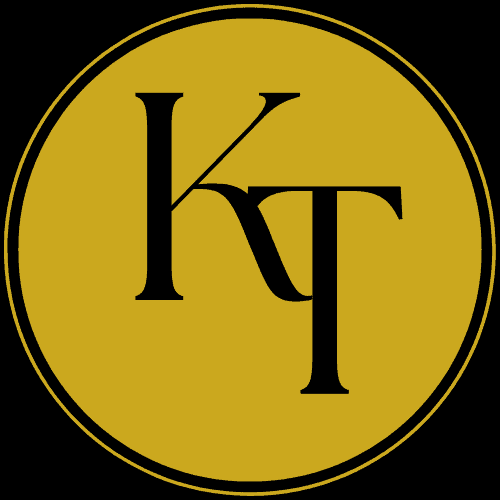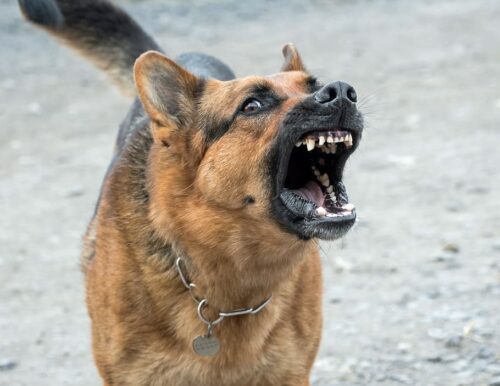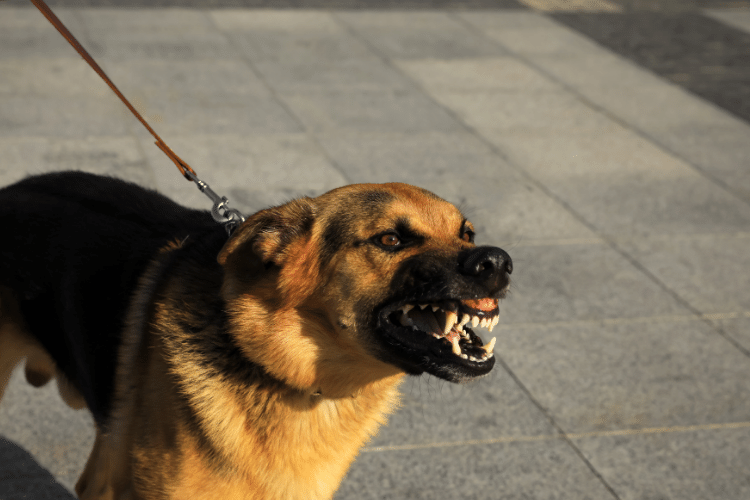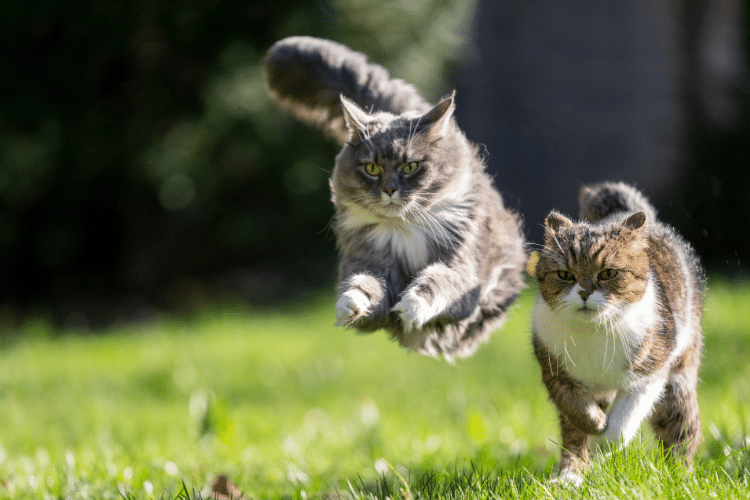
Have you fantasized about sailing over hedges? If yes, keep on reading! As a horse enthusiast, you are aware of how difficult it might be to select the ideal horse from hundreds of breed varieties. Horses were originally utilized as working animals that could perform a range of chores, including pulling bricks, hauling plows, and even serving as a means of transportation. However, these days, horses are largely used for enjoyable fun activities like dressage, horse jumping, and racing. Selecting a partner for the riding adventure is more important than simply getting a gorgeous mane for yourself. In the same way, no horse breed is ideal for novices or first-time owners; some are just better than others due to certain features they possess. As always, choosing the right horse that best meets your demands is the key to safety.
So personality, experience level, and ability to train should all be taken into account when selecting a horse for the first time. They can be hefty and powerful, which is great for working and racing; quick and agile, which is great for leisure riding and horse competitions; or calm and gentle, which is good for first-time owners. Every breed of horse, from the popular Arabian to the spotted Appaloosa, is unique. Let’s dive into the list of the top 10 best horse breeds around the world, based on factors like popularity, temperament, adaptability, traits, trainability, strength, and qualities.
- Arabian Horse
- Friesian Horse
- Marwari Horse
- Mustang Horse
- Andalusian Horse
- Appaloosa Horse
- Icelandic Horse
- American Quarter Horse
- Morgan Horse
- Thoroughbred Horse
1. Arabian horse – Most famous breed:
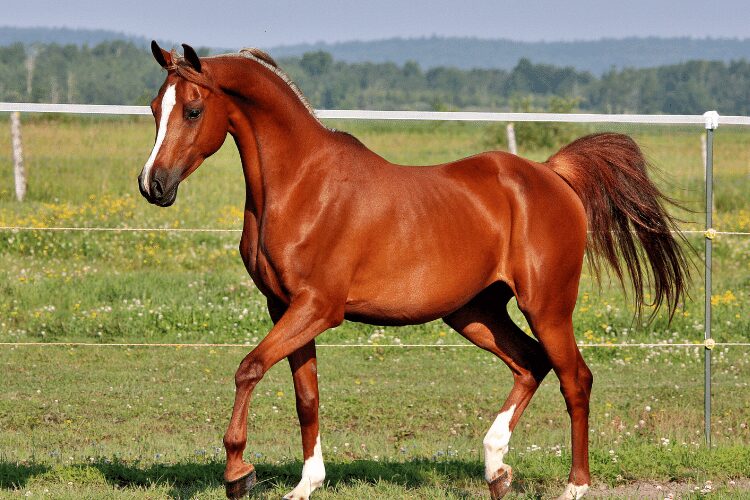
Nobody can resist the breathtaking beauty of the most well-known breed, the Arabian horse, which originated about 4,000 years ago on the Arabian Peninsula. Although there are many different shades of this oldest registered horse breed available, the most common ones are grey, chestnut, black, bay, and roan. These highly sought-after breeds excel in endurance riding and compete mostly in International competitions like the Tevis Cup and the Equestrian Games. They are also frequently seen in racing, dressage, trail riding, eventing, and many other sports. Due to their reputation as hot-blooded breeds, Arabians are best suited for seasoned riders; novices may find them too strong to handle. On the contrary, they are among the most intelligent, athletic, and adaptable horse breeds because they adore their riders, obey their orders, and show more love than other horses. Their color is black at birth and becomes lighter as they mature.
By providing speed, strength, and endurance suitable for withstanding the rigors of the desert, they have helped other modern horse breeds to develop in quality. Half-Arabians typically turn into outstanding pleasure riders and saddle horses. A few examples of 50%-Arabian breeds are the Morab, which is half Morgan and half Arabian, and the Anglo-Arab, which is half Thoroughbred and half Arabian. Being in the spotlight all the time, be it in the show ring or on a trail ride, and being less prone to spooking in unexpected situations, makes this Arabian one of the best horse breeds in the world.
- Height: 14 – 16 hands or 56 – 64 inches
- Weight: 800 – 1,000 pounds or 370 – 450 kg
- Speed: 40 mph or 65 km/h
- Life expectancy: 25 to 30 years
- Best for: Horse racing, dressage, equestrian games, and endurance riding.
- Physical characteristics: Small head, protruding eyes, broad nostrils (to facilitate breathing in their natural desert habitat), marked withers, short back, high tail carriage, inward-curving ears, and long, arched necks. Due to the fact that Arabian horses often only have 23 vertebrae, compared to other breeds’ standard 24 vertebrae, many Arabian horses have shorter backs than other breeds.
- Temperament: Eager to please, lively, spirited, gentle, alert, and renowned for their ability to bond with humans.
- Qualities: Speed, beauty, intelligence, greatest stamina and endurance.
- Trainability: Smart breeds that are sensitive, and has lightning-fast learning. When Arabians receive training by someone untrained or extremely strict, these traits may backfire.
- Adaptability: Able to go for extended periods without consuming food. Their huge lungs were designed to help them with endurance, while their shorter, stocky bodies were beneficial for better balance and movement in the dense desert sands.
- Strength: Despite challenging conditions, they maintain their endurance and athleticism.
2. Friesian horse – Most powerful breed:
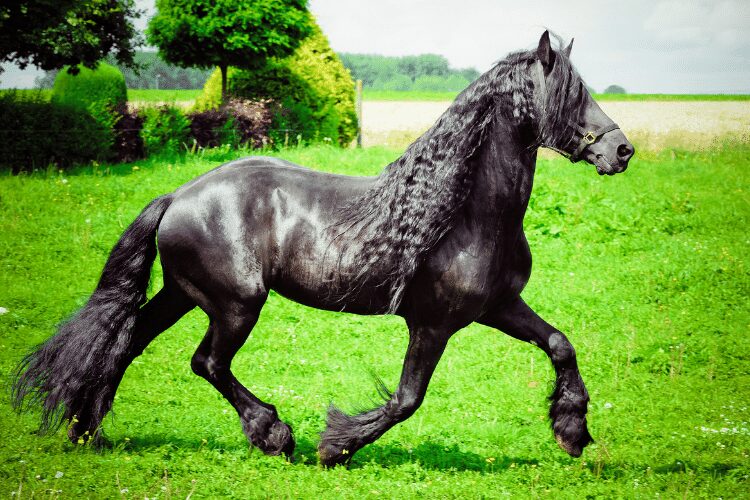
The Friesian, one of the best, rare and robust horse breeds, is indigenous to the province of Dutch Friesland. Because of their scarcity, Friesian horses are highly sought-after, valued, and pricey. In 1913, there were just three Friesian stallions, and things looked hopeless. However, the Friesian breed centers helped this remarkable breed continue to thrive. Also nicknamed “Belgian Blacks,” they have a phenomenal appearance that makes it difficult for anyone to ignore. Owing to their robust gait, endurance, and strength, they are said to have been employed as workhorses for centuries and as warhorses during the medieval era, despite being the smaller counterpart of the draft horse. Exceptionally feathered legs, shining black coats, a long mane, and a tail make this Friesian horse easy to identify.
These superb horses are frequently utilized in dressage and other performance events because of their elegant movements, high-leg actions, and floating trots. Additionally, it is utilized for horse racing, recreational riding, ceremonial carriage pulling, and riding for fun. The breed’s population is increasing because of its growing popularity, even though it is in danger of going extinct.
- Height: 15 – 17 hands or 60 – 68 inches
- Weight: 1200 – 1400 pounds or 544 – 635 kg
- Speed: 45 mph or 72 km/h
- Life expectancy: 16 years
- Best for: Leisure riding, shows, racing, ceremonial and working purposes.
- Physical characteristics: Long, arched necks, well-chiseled short ears, sloping shoulders, muscular physiques, powerful legs and hindquarters, thick, wavy manes and tails, extremely feathered lower legs, and glossy black coats.
- Temperament: Kind, friendly, energetic, calm, desire to please, docile, and gentle.
- Qualities: Brisk, speed, agile, versatile and intelligent.
- Trainability: Learns very quickly, easy to train, and can excel in any disciple in a short period and suitable for less experienced riders.
- Adaptability: Adapts to all sides like working on the land or performing in the circus or simply riding.
- Strength: High speed in trot, graceful gaits, expressive face.
3. Marwari horse – Best battlefield companion:
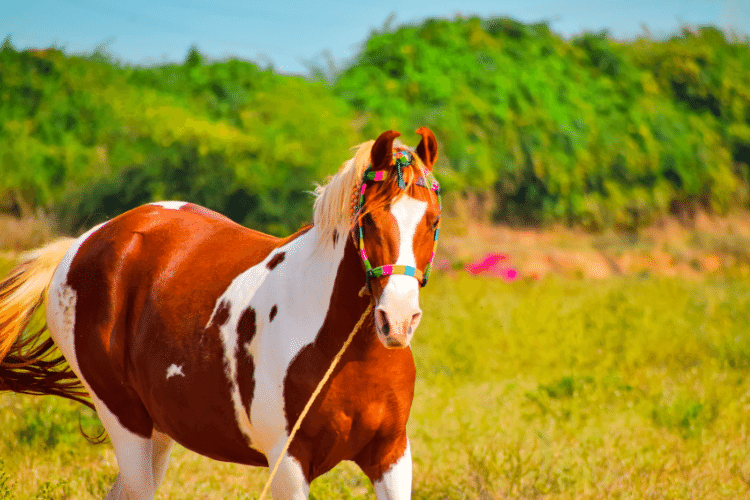
Our next pick is the courageous Indian Marwari horse, also referred to as the “Breed of Battles.” Their large ears, which curl inward, instantly set them apart. These ears are the most reliable in war since they can turn 180 degrees, touch at the tips, and revolve to detect even the slightest sound. The Marwari horse was the reason behind the British force’s persistent inability to assassinate any Mughal generals; when they detect an approaching threat, their ears begin to rotate in that direction, alerting the Mughal generals to the potential danger. Hailing from Rajasthan’s Marwari region, this horse was traditionally used in cavalry sectors and dates back to the 12th century. Only accessible to noblemen, Marwari horses are a symbol of royalty and are crossbred between Arabian horses and local ponies. After many decades, it became well-known in India and expanded globally.
They come in a variety of hues, including bay, black, chestnut, and grey, with some individuals even displaying unique patterns such as pinto or roan. Renowned for their endurance, these animals were taught intricate prancing and leaping movements for ceremonies. They were also utilized in endurance riding, dressage, open jumping, and horse safaris. All things considered, the most active and strong Marwari horse is a fantastic breed that flawlessly blends intelligence, athleticism, and beauty. The remarkable attributes of the Marwari horse are likely to make an impression, whether you’re searching for a trustworthy trail-riding partner or an ambitious show horse.
- Height: 13 – 14 hands or 52 – 56 inches
- Weight: 750 – 805 pounds or 340 –365 kg
- Speed: 25 mph or 40 km/h
- Life expectancy: 25 to 30 years
- Best for: Leisure and endurance riding, mounted jumping, shows, competition, horse safaris, ceremonial & religious purposes.
- Physical characteristics: Medium-height horses with strong legs, small hooves for long-distance riding, inward-turning ears, high-arched necks, deep chests, muscular shoulders, and sloping croup.
- Temperament: Hot blood, energetic, sensitive, tenacious, social, sturdy, unpredictable, negligence will not be tolerated.
- Qualities: Brisk, loyal till death, speed, agile, intelligent, elegant, confident, love, bravery and faithfulness.
- Trainability: Performs tasks very well, quick learner, proper training needed, excels in any disciple, and is not suitable for novice riders.
- Adaptability: Adapts to diverse terrains, and climates and has great stamina to endure tough desert conditions with little water and food.
- Strength: Courageous and able to react to frontal assaults in a matter of seconds, it can lift three times its body weight, powerful physique, graceful jumps.
4. Mustang horse – Iconic breed:
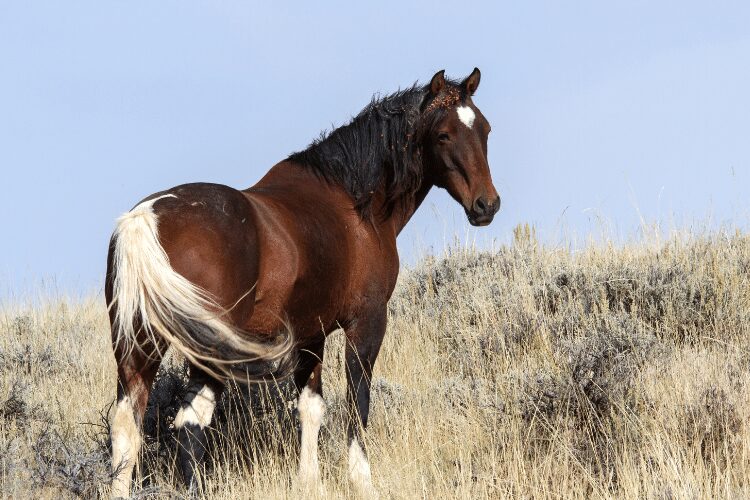
The Spanish explorers of the 16th century brought the native breed, freely wandering horses from Western America. The Spanish terms “Mestengo” and “Mostrenco,” which translate to “Wild or Masterless Cattle,” are the source of this majestic creature’s name, which embodies the elegance and independence of the wild. To put it simply, feral Mustangs are those that live in the wild. Mustangs are very amazing to behold because of their unique appearance, which consists of muscular structures, firm hooves, robust legs, and a flowy mane and tail. The original Mustangs were crossed with many domesticated horse breeds over time, so today’s Mustangs usually have a mix of multiple breeds, giving them a range of looks, including solid coats, eye-catching pintos, and dapples. In addition to draft versions of Mustangs, large Mustangs are developed for working purposes. They are intelligent, flexible, and capable of succeeding in various activities, including roping, barrel racing, ranch work, and trail riding.
Despite their reputation for being wild animals, they are actually quite trainable, can be ridden like regular horses, and have close relationships with their human caretakers. However, taking Mustangs straight from the wild, as opposed to breeding them in captivity, will prolong their training period. They are among the best horse breeds in the world and make wonderful companions for riders of all skill levels because of their power, swiftness, endurance, devotion, and desire to please.
- Height: 12 – 14 hands or 48 – 56 inches
- Weight: 800 pounds or 365 kg
- Speed: 25 – 30 mph or 40 – 48 km/h
- Life expectancy: 25 to 30 years
- Best for: Pleasure riding, ranch work, endurance riding.
- Physical characteristics: Well-built body with a low-set tail, robust muscles, and hard hooves. Because of their mixed ancestry, Mustangs exist in every color, and they sometimes have primitive markings.
- Temperament: Hot blood, energetic, sensitive, tenacious, social, sturdy, affectionate, calm, well-mannered with proper training, gentle, and incredibly dominant with others.
- Qualities: Brisk, speed, agile, intelligent, elegant, confident, brave, faithful, and surefooted.
- Trainability: Performs well, quick learner, proper training needed, wild-bred Mustangs are not suitable for novice riders since they require skilled handling as well as training; but, once adjusted to human company, they become loving friends.
- Adaptability: Within minutes after birth, horse foals may stand and often get ready for running within a few hours. To obtain moisture from the plant, they eat prickly cactus during hot and dry seasons. Skilled at picking his way around the edges of ponds that are frozen over, and also winter watering holes, without breaking through the ice.
- Strength: Bravery, incredible stamina, able to effortlessly pull about 15–20% of its body weight, plus the weight of the rider and any equipment, excellent trail and working horses because they can cope with terrain that other breeds may find difficult.
5. Andalusian horse – Most beautiful breed:
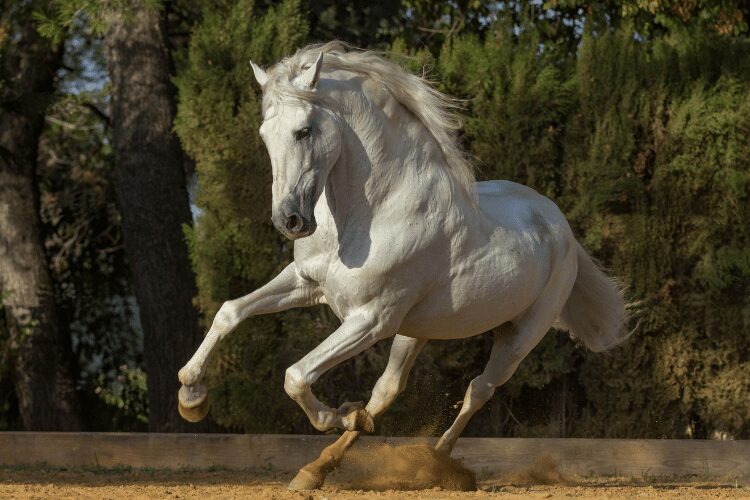
Andalusian horses are the only breed with an eye-catching, polished look combined with a strong physique and impressive athleticism. They originate from Andalusia, in southern Spain, on the Iberian peninsula. They were employed as war horses in the past and are still utilized for driving, dressage, show jumping, and leisure rides. In addition, they are frequently used in TV shows and films. Andalusians, usually referred to as pure Spanish horses, are regarded as one of the most well-liked horse breeds in the world right now since they have maintained their original traits over time. With its true moves, Andalusian is undoubtedly an attention-grabber in the dressage ring.
Although Andalusians are primarily gray, their distinctive features also make them stand out in shades of bay, black, and chestnut. With time, the gray overcoat will become lighter, giving them a striking pearl or silver look that is renowned for its elegance and grace. The Bay Andalusian breed, with its rich chestnut coat and black points, is a favorite among equestrians for its athleticism and agility. Black Andalusian horses are often used in dressage and elite competition due to their muscular frame and silky black coats. These horses will undoubtedly leave a lasting impression on whoever is fortunate enough to ride them, thanks to their stunning appearance, exceptional talent, and gracefulness.
- Height: 12 – 14 hands or 48 – 56 inches
- Weight: 900 – 1100 pounds or 410 – 510 kg
- Speed: 45 mph or 73 km/h
- Life expectancy: 25 to 35 years
- Best for: Dressage, leisure and trail riding, show jumping, and events.
- Physical characteristics: Compact and well-built, with long, silky manes and tails, a slender head, small ears, strong legs, firm joints, thick hooves, a flat-convex nose, and a muscular neck.
- Temperament: Kind, calm, energetic, athletic, sensitive, tenacious, generous, noble, docile, social, affectionate, versatile, charismatic, gentle, pleasant and willing nature.
- Qualities: Speed, agile, intelligent, elegant, beauty, confident, and ability to quickly learn difficult moves.
- Trainability: Perform complex moves well, fast learner, easy to train and manage, learns efficiently, can follow orders.
- Adaptability: Very versatile and adaptable to situations.
- Strength: Stamina, expressive and elevated movements, easily moves with the grace of a ballerina and the strongness of a matador.
6. Appaloosa horse – Unique spotted breed:
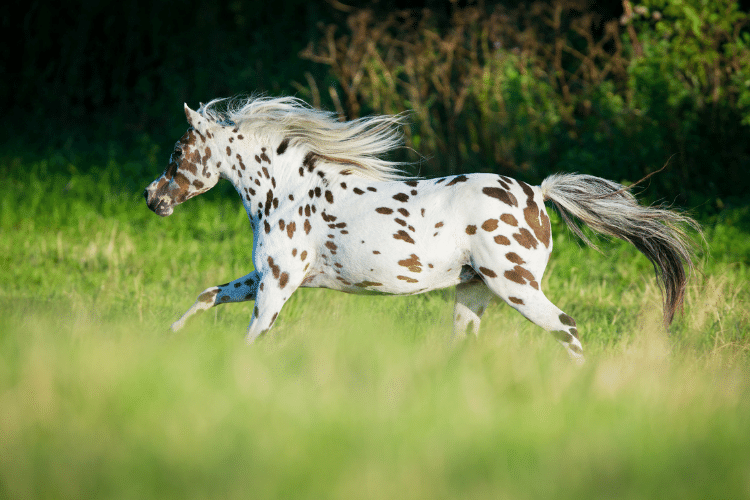
The distinctively striped hooves, white sclera, and exquisitely speckled coat patterns of the Appaloosa horse are what makes it a popular breed in North America. Originally bred with mixed breeds such as Thoroughbreds, Mustangs, and more by the Nez Perce tribe for hunting and warfare, they were used to carry babies on cradleboards. They were on the verge of extinction in the 19th century, but luckily they were preserved and became well-known worldwide. Although this breed has numerous unique coat patterns, the well-known five patterns are as follows:
- Spots: The body has a lot of dark or white spots all over it.
- Leopard: Spotted horse, either white, black, brown, or white with black spots.
- Blanket: Solid-coated horse with huge white spots covering the back near the tail.
- Snowflake: The black base of this Appaloosa is speckled with white dots.
- Roan blanket: This sort of blanket is identical to the white variety, except it is colored darkly or roan instead.
True black is the rarest coat color for an Appaloosa, while the leopard complex-spotted pattern is the most common. For their coats to be healthy and in excellent condition, they need to be groomed regularly. They feature unique black skin patterns around their eyes, nose, and genital areas, which are called “mottling”, besides their patterned coat. The tissue that encircles the pupils of the eyes and gives them a typical human appearance is called the “white sclera”. They also have striped hooves, where the horse has strong, noticeable, vertically light or dark stripes. Last but not least, Appaloosa horses have remarkable eye colors such as brown, blue, or hazel, or even two different hues. These adaptable horse breeds are bright and clever, and they excel in a variety of jobs, including dressage, light work, herding, and recreational riding.
They also do exceptionally well in three-day events, Western and English events, trail riding, and farm work. Owing to their reserved nature, they frequently appear in Hollywood films. Appaloosas are among the best horse breeds for children to ride and handle, as well as for novice and expert riders, due to their calm attitude, trustworthiness, and willingness to please.
- Height: 14.2 – 16 hands or 56 – 64 inches
- Weight: 1000 – 1100 pounds or 454 – 500 kg
- Speed: 41 mph or 66 km/h
- Life expectancy: 25 to 35 years
- Best for: Trail riding for pleasure and distance, light work on ranches, family horses, and a variety of other Western and English riding activities.
- Physical characteristics: Unique coat pattern colors like bay, black, chestnut, palomino, and even grey; mottled or marbled skin patterns, white sclera around the eyes, obvious hoof stripes, feature distinct eye hues and some horses with slender manes and tails.
- Temperament: Level-heads, submissive, quiet, bold, spirited, kind, sociable, versatile, energetic, athletic, docile, and patient.
- Qualities: Versatile, intelligent, gentle, compact, quick, mild-mannered, trustworthy mount for children.
- Trainability: Easily trainable, fast learners, loving companions, require trust and respect from the beginning; because of their personality, they are appropriate for both children and riders with varying levels of expertise.
- Adaptability: Tolerant to various riding styles, eager to work, and thrives in both extremes of temperature given the right shelter and care.
- Strength: Multi-talented to do a variety of works, pleasant and affectionate family companions.
7. Icelandic horse – Fun ride breed:
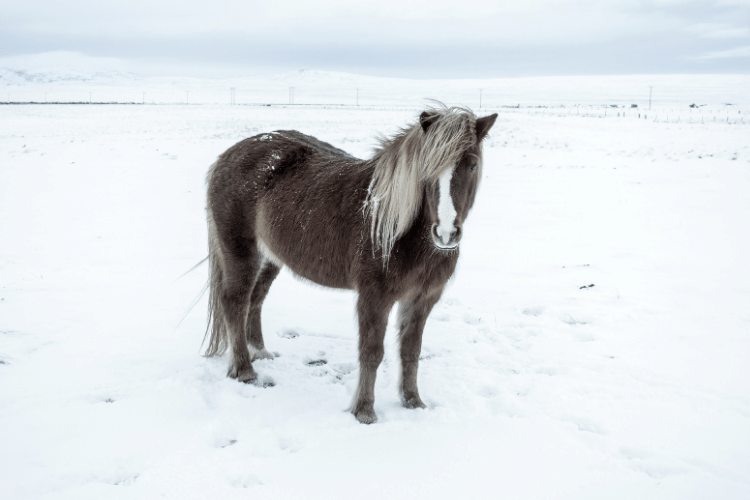
The Icelandic horse, which is small and pony-sized, originated over 1,000 years ago, is considered to be one of the most pure breeds worldwide, devoid of any genetic influence from other horse breeds. With only a little amount of livestock to bring with them, the early immigrants to Iceland selected only the best and highest-quality animals to ensure their owners would survive the arduous journey across this huge country. This breed was initially isolated on an untamed island in the North Atlantic. Because they are located separately and none of the horses will return to Iceland after they depart, very few diseases develop, and vaccines are not necessary. To minimize problems, visitors to that island are asked not to bring any protective gloves, riding boots, or other equipment they use in Iceland.
Polo, barrel racing, carriage hauling, pleasure riding, and endurance racing are all ideal for these incredibly smooth horses. When it comes to discovering hills, valleys, and rough terrain, no other breed can match them. They are also capable of accommodating riders of various sizes. With their extraordinarily thick coats and manes, these horse breeds can flourish in frigid temperatures and navigate across tough terrain with little difficulty.
These sturdy-hardy jumpers have five natural gaits (patterns of foot motions). While all horses typically have three, walk (single or both legs touching the ground in a slow, symmetrical 4-beat gait), trot (diagonally moving legs in a quick, bouncy two-beat routine), gallop (controlled three-beat gait ranging from slow to fast), they also have these special parts, “tölt” (a flexible, four-beat gait in which they move forward with ease), and lastly, “flying pace” (two-beat gait, front and rear legs are simultaneously moved on the same side). One of the best horse breeds for novices interested in trail riding is the Icelandic, which is recognized for its flowing gaits that make riders feel secure in the saddle. With their exceptional ability to carry out five different gaits, including the famous tölt, there is no better choice for riders looking for a reliable and versatile mount.
- Height: 13 – 14 hands or 52 – 56 inches
- Weight: 730 – 840 pounds or 330 – 380 kg
- Speed: 30 mph or 48 km/h
- Life expectancy: 25 to 30 years
- Best for: Pulling loads, carrying people, sheep herding, leisure riding, long-distance or short therapeutic ridings.
- Physical characteristics: With their compact rectangular bodies, sloped croup, and a coat of two layers meant to provide extra warmth in cold temperatures, these animals are tiny, robust, and squat-legged. They also have long cannon bones, short pasterns, a straight facial profile, a broad forehead, a long back, a deep chest, shaggy fur, and the mane and lowered tail are covered in coarse hair.
- Temperament: Kind, sociable, friendly, docile, enthusiastic, self-assured, easy-going, adventurous, gentle, and willing to work.
- Qualities: Lack the spookiness, trustworthy, patient, competitive, and talent.
- Trainability: Initial training needed, easily trainable, quick learners, easy to handle, and contact with humans required.
- Adaptability: They don’t need expensive grasses and can adjust to various plants. They are housed outside during the winter and can withstand harsh conditions and even cross rough terrain and glacial rivers. Furthermore, they typically produce a thick coat in the winter, which they lose in the summer.
- Strength: Naturel jumpers, tremendous stamina, versatile enough to perform a wide range of tasks, superb swimmers, able to pull huge loads and carry riders at the same time, and able to perform five gaits.
8. American Quarter horse – Best sporting breed:
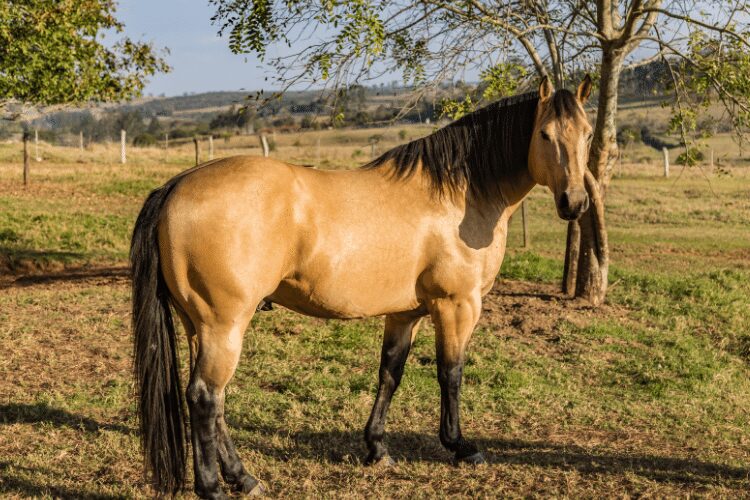
Every novice rider aspires to ride an American Quarter horse, a breed renowned for its quickness, agility, serene, and kind demeanor. This well-known horse was developed in the 1600s in England by crossing Spanish Thoroughbreds with native breeds, such as Chickasaw horses. It is regarded as one of the oldest and largest horse breeds, with millions of individuals. This breed is so quick that a Quarter horse has been reported reaching 55 mph (88.5 km/h), possibly making them the fastest horse breed worldwide. On average, they can cover a quarter of a mile faster than all other kinds of horses in less time. They were utilized in the 1800s to carry cowboys over the desert and to herd cattle. Today, they are employed for a range of ranch tasks and recreational riding in addition to racing, riding, cutting cattle, eventing, and rodeos.
Because of their sturdy physique and powerful hindquarters, Quarter horses are among the most popular horse breeds globally. They have become so common in the US that no equestrian adventure would be complete without one of these dependable horses. They are available in 17 different hues, including white, black, brown, gray, bay, palomino, buckskin, dun, roan, and chestnut. These horses are impressive in every way, from their calm strolls to their unbelievable speed. They are the ideal option for riders seeking a steady and patient horse to assist them in learning.
- Height: 14.3 – 16 hands or 57 – 64 inches
- Weight: 950 – 1200 pounds or 430 – 544 kg
- Speed: 44 mph or 71 km/h
- Life expectancy: 25 to 35 years
- Best for: Racing, working, leisure riding, and rodeo events.
- Physical characteristics: There are two primary body kinds: the stock variety is shorter, more compact, and well-muscled, while the racing and hunter varieties are taller and have smoother muscles. Both have a tiny, refined head, a muscular neck and torso, a broad chest, round, powerful hindquarters, and robust legs.
- Temperament: Kind, quick, sociable, friendly, gentle, calm, docile, versatile, intelligent, hard-working and eager to please.
- Qualities: Trustworthy, cooperative, loyal, competitive, sheer speed, agile, and athletic.
- Trainability: They are an excellent option for riders of all skill levels, including families and novices, due to their highly trainable and manageable nature.
- Adaptability: It can adapt to almost any purpose like racing, working and surroundings.
- Strength: Stamina, speed, excels at sprinting short distances, and amiable nature.
9. Morgan horse – All in one breed:
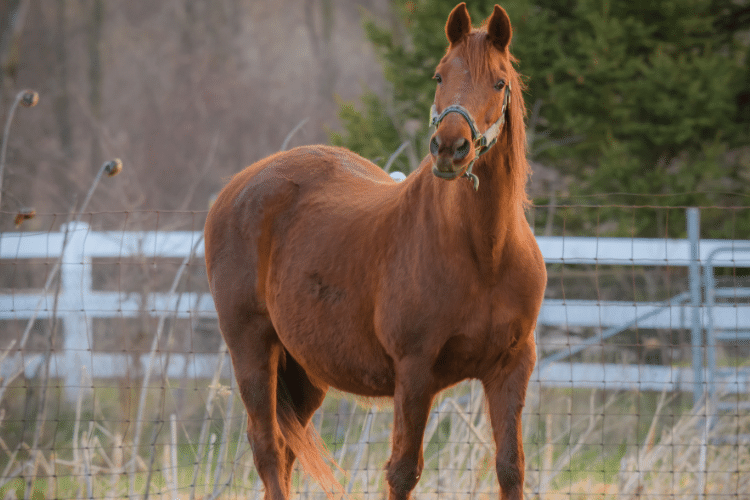
The Morgan horse is the world’s best horse breed and an excellent fit for light carriage rides because of its striking looks, expressive face, robust build, and adaptive nature. This legendary breed originated in the 1700s from an individual sire in West Springfield, Massachusetts, in the United States. Named after its owner, Justin Morgan emerged into fame for his remarkable strength and willing nature. It was crossbred with other mares, and the resulting offspring were named Morgan. These little, compact horses have everything you could need for a competitive sports horse or riding buddy. This official animal of Vermont is widely sought after by a variety of disciples, including eventing, endurance, trail, leisure, and even parade riding.
They are understanding of inexperienced riders and eager to obey orders from more seasoned riders. Though they come in a range of hues, the most popular ones are bay, black, and chestnut. Dilutions of cream are also occasionally found. They are a well-liked option for riders of all skill levels due to their effortless expression and natural athleticism. The Morgan horse can be the ideal option for you if you’re searching for a horse that is not simply gorgeous but also talented and trustworthy.
- Height: 14.1 – 15.2 hands or 56 – 61 inches
- Weight: 900 – 1100 pounds or 408 – 500 kg
- Speed: 20 mph or 32 km/h
- Life expectancy: 20 to 30 years
- Best for: Family horse, beginner equestrians, saddle leisure, endurance, and trail riding.
- Physical characteristics: Elegant heads, finely arched necks, sturdy legs, somewhat convex profiles, broad foreheads, huge, prominent eyes, and relaxed shoulders characterize these compact, tiny, and robustly built individuals.
- Temperament: Friendly, gentle, spirited, willing, docile, hard-working, eager to please, versatile, attentive, affectionate, and bold.
- Qualities: Trustworthy, cooperative, agile, athletic, beautiful, stylish walk, intelligent, courage, and sensible.
- Trainability: Highly trainable nature, quick learners, easy keepers, making them a great choice for riders of all levels including beginners and family.
- Adaptability: It can adapt to any purpose like racing and working, health issues are rare, thrives in cold climates, and requires warm temperatures but can’t withstand hot and humid days.
- Strength: Super stamina, multi-talented, patient, excels at leisure rides, endurance to ride for extended periods without getting tired, known for its ability to pull massive stumps and heavy logs, speed in races, ease in rideability, and expressive eyes.
10. Thoroughbred horse – Athletic breed:
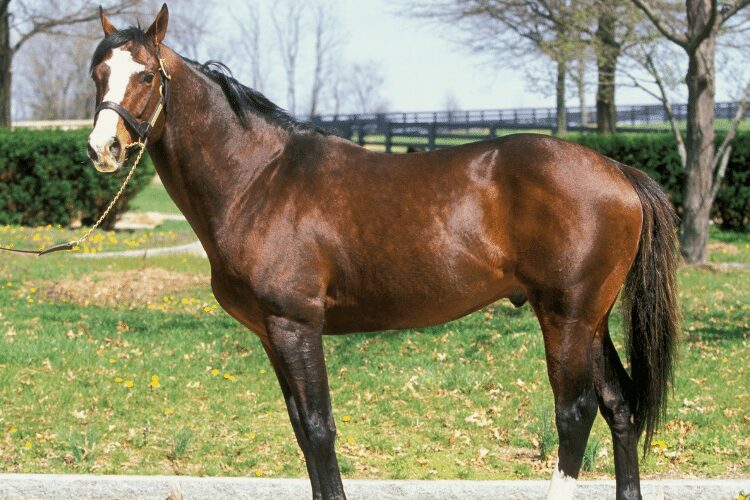
Would you like to know which horse is the fastest in the world? I wanted only those specific people who have been waiting until the very end to find out the best—or perhaps the most desired part! In the world of the horse kingdom, Thoroughbreds are the fastest runners. If Thoroughbreds and Quarter horses compete in a race, the Thoroughbreds will continue to gallop over the quarter-mile mark, with the fastest of them reaching speeds of up to 44 mph. This interesting breed of horse was created in England in the seventeenth century primarily for racing; however, it was later imported and went on to influence other horse breeds, including Quarter and Standardbred horses. These are popular horse breeds that are well-suited for the racetrack and are best renowned for their racing talent, endurance, agility, and speed. But they are more than just one-trick ponies; they are the top acts in dressage, eventing, and show jumping. All in all, they are like a big cat and a ballet dancer combined into one.
After retirement from racing, the majority of Thoroughbreds go on to pursue second careers as riding companions. Despite their racing pedigree, they make excellent companions for families and beginners. Black, brown, gray, bay, and chestnut are the most common colors of these magnificent beasts. One of the best breeds in the world, Thoroughbreds are certain to turn heads in their shows with their exquisite appearance and graceful gaits. Thoroughbred horses are a great choice for anyone looking for a reliable, versatile, and steadfast friend.
- Height: 15.2 – 17 hands or 61 – 68 inches
- Weight: 900 – 1200 pounds or 408 – 544 kg
- Speed: 44 mph or 71 km/h
- Life expectancy: 25 to 35 years
- Best for: Family horse, beginner equestrians, leisure riding, show jumping, and dressage.
- Physical characteristics: Attractive heads, long, arched necks, fine legs, slightly convex profiles, broad foreheads, huge, prominent eyes, laid-back shoulders, high withers, deep chests, short, curved backs, wide hips, and thin bodies characterize these compact, petite, and firmly built individuals.
- Temperament: Kind, sociable, friendly, gentle, spirited, calm, docile, versatile, attentive, affectionate, and bold.
- Qualities: Trustworthy, Cooperative, agile, athletic, loyal, intelligent, willing, brave, and loving with their human.
- Trainability: Highly trainable nature, quick learners, needs extensive exercise, ideal choice for beginner riders and family companions.
- Adaptability: Thoroughbreds will often feel the cold and will require appropriate rugging to maintain their weight, especially if they are prone to losing weight in the colder months.
- Strength: Super stamina, multi-talented, full of energy, and powerful work ethic.
Conclusion:
Now that we are at the end of our horsey list, we hope you are much more familiar with these horse breeds. These are just a few of the best horse breeds, as we are blessed with abundance of them. Each kind has its own characteristics, and older horses are way more predictable than younger ones. So a horse with a calm and trainable nature that provides a smooth ride will be the best fit for beginners, while a mature, well-trained horse is for experienced riders. Just being a popular breed doesn’t mean it needs to be your equestrian companion! Make sure these horse breeds match your personal preferences, equestrian goals, and riding style.
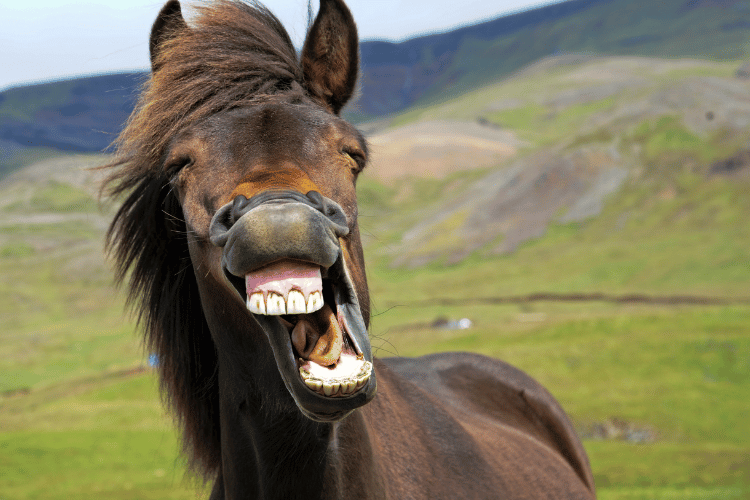
The best way to figure out which horse is ideal for you is to spend time with them. With that being said, do your own research and choose the ideal match for you! Whether you are looking for a beautiful companion for your leisure riding or a racing partner, this list of the top 10 best horse breeds in the world would make an excellent choice. Are you enjoying this content? Leave us a comment on which horse breed attracted you the most. Thanks for reading, and for now, goodbye!
FAQs:
1.How many horse breeds are there?
There are more than 350 different horse breeds in the world.
2.Which is the biggest horse breed?
The Shire horse aka Gentle giants is the world’s largest, followed by the Clydesdale.
3.Which is the fastest horse breed?
Thoroughbreds are the fastest with a top speed recorded of 71 kilometers per hour.
4.Which is the beautiful horse breed?
The Friesian horse that are native to the Netherlands are the most beautiful.
5.What distinguishes English and Western riding styles?
While Western riding involves the rider using only one hand on the reins for control, English riding involves the rider using the two hands to control the horse’s direction and speed.
6.Among the breeds of spotted horses, which one is the most famous?
American horse breed, Appaloosas are the most well-known spotted horse breeds.
7.Which breeds to avoid?
Avoid Akhal-Teke horses, as they can be challenging to manage for those with little to no experience.
